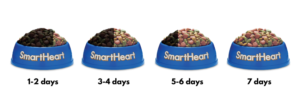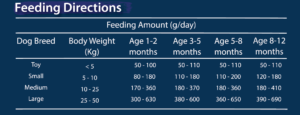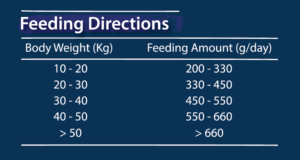
Understanding Your Dog’s Protein Needs
A dog’s protein requirements may vary depending on many factors, including:
Life Stage
Puppies require more protein than adult dogs, as they are in a stage of rapid growth and development. For that reason, adult dogs need complete and balanced food that provides all necessary nutrients that are compatible with their maintenance and activity. Senior dogs of 7 yr or older are less active but still need enough protein to support their muscle mass. However, senior dogs may need fewer calories and more antioxidants as protection from obesity and age-related diseases.
Here’s how much protein your dog requires based on AAFCO:
- Puppies and pregnant/nursing dogs: 22.5% crude protein minimum
- Adults: 18% crude protein minimum
SmartHeart Dog offers a dry food selection for both puppy and adult dogs that is tailored for different protein and other nutrition needs.
Breed Size
Protein needs may also differ from one breed to another, especially giant breeds, such as the Great Dane and Irish Wolfhound require higher protein content in their diet as they have more muscle mass than smaller dogs.
Activity Level
Active dogs like Shepherds, Huskies, or working dogs have a more substantive energy level and thus need higher protein dog food for muscle maintenance, and energy. Other primary benefits should be considered so that the focused breed’s energy-plus nutrition is well controlled, such as for strong bones – calcium; for skin and coat – Omega 6; and for digestibility and energy – carbohydrates. More specifically our Power Pack is ideal for energetic and active breeds with a minimum of 30% Crude protein to suit the needs of energetic dogs.

Health Condition
Some health conditions require a higher or lower protein consumption, and they should adjust their protein consumption according to their vet’s advice. For instance, dogs with chronic kidney disease (CKD) are known to benefit from diets with less protein.
Tips for Transitioning to High-Protein Food
Gradual Introduction: To save your pet’s tummy from upset, mix and slowly increase the amount of the new meal with the old food for a week. You are recommended to refer SmartHeart’s meal transition guide as below.

Follow our feeding direction according to your dog’s life stage and size.
Monitor Your Dog’s Response: Major changes in their energy levels, the condition of their coat, or bowel movements are other important things to look out for. The diet may need to be altered if needed, depending on what is best for the dogs.
Consult Your Veterinarian: It is always advisable to seek advice from a veterinarian especially if your dog has any complications with digestion or any other health conditions.
To ensure optimal health and happiness, feed your dog a high-protein diet. Knowing what your dog needs for protein, understanding the quality of protein sources, and reading the labels on dog food can help you make a more educated decision. It doesn’t matter if your dog eats cooked food, wet food, dry kibble, or raw food; what matters more is it be meticulously picked with all matters under control to make it a balanced and nutrient-rich diet for the dog’s overall support in its health. Please consult your veterinarian to provide your pet with the perfect high-protein meal ever.









